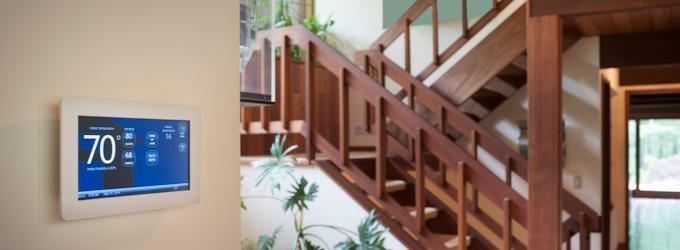Control Your Residential Heating and Cooling System With the Latest Technology
Smart thermostats have changed the way we utilize our residential HVAC to keep our St. Louis homes comfortable in all four seasons.
If you haven’t transitioned to this new technology, you may be missing out on some key benefits. Keep reading to find out whether investing in a smart thermostat is worth it.
What Is a Smart Thermostat?
A smart thermostat is a Wi-Fi enabled controller for your residential HVAC. It automatically adjusts your home’s temperature settings to ensure the most efficient function of your heater or air conditioner. Smart thermostats can be conveniently controlled from an app on your smartphone.
Benefits of Using a Smart Thermostat
People have made the switch from standard digital programmable thermostats or mechanical thermostats for a variety of reasons, but they can be boiled down to improving efficiency, accuracy, convenience, and utility costs.
Programmable Residential Heating and Cooling System Settings
A smart thermostat adjusts your home’s interior temperature by following a program you create and enter into an easy-to-use smartphone app. You can change your schedule at any time.
Many users find smart thermostats to be the most convenient choice because they require so little manual adjustment.
Accurate Temperature Readings
Because smart thermostats operate using digital components, they provide more accurate temperature readings than older thermostats, especially manual ones that feature round knobs.
Digital components sense the interior temperature of your home and prompt your residential heating and cooling system to turn off and on when necessary. You can adjust the temperature with the touch of a button rather than with the imprecision of turning a dial.
Learning Your Habits
Smart thermostats are unique from standard programmable digital thermostats in that they can actually “learn” your household habits and adjust to your preferences based on time of the day and day of the week.
Although it takes a couple of weeks for the thermostat to adjust to your habits, the data it collects allows it to warm or cool your home when you want it to. For example, if you work outside your home during the day, it can adjust to energy-saving temperatures while you’re away. Some can even take weather into account when adjusting its settings, thanks to Wi-Fi connectivity!
Smart thermostats use motion sensors to detect when you’re home, but this is only most effective when they’re located in a high-traffic area. Consider having a professional technician activate your smart thermostat during a residential HVAC maintenance visit or a residential heating installation of new equipment, especially if your thermostat will require relocation from its original spot in your home.
The Ability to Control Your Residential HVAC from Anywhere
You have the power to adjust your smart thermostat while you stay in bed or when you’re away at work, thanks to connected apps. That means you can warm up your home in the winter before you get out of bed, or cool your house down in summer while you’re on your way home from work.
The smartphone app that pairs with your device also allows you to monitor your home while you’re away, ensuring it stays at a comfortable temperature for pets and house sitters. Some apps will even alert you if you need residential HVAC maintenance or repairs.
Utility Bill Savings
The numerous benefits of smart thermostats culminate in a major reward: lower utility bills. Smart features ultimately allow you to reduce your energy consumption while your house stays comfortable.
Many smart thermostats generate energy consumption data reports, which show you the amount of energy you consume and when, so you can make adjustments during peak periods.
The return on investment for these devices is fast, so don’t let the initial purchase price deter you! Better still, as the technology develops, more affordable equipment becomes available, so you’re likely to find a smart thermostat at a price that fits your budget.
How to Add a Smart Thermostat to Your Residential Heating and Cooling System
Find the right smart thermostat for you by:
- Comparing thermostat features and prices online, such as on manufacturer websites or big box hardware store websites.
- Asking a trusted local HVAC service provider for their advice.
When you choose the right smart thermostat for your St. Louis household, you’re making a worthwhile investment in your home’s comfort. Regardless of your approach, you’ll be one step closer to reaping the rewards of an up-to-date residential HVAC system.


